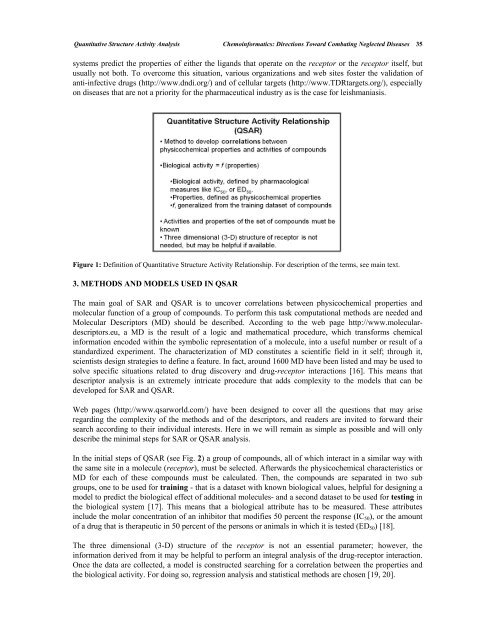chapter 1 - Bentham Science
chapter 1 - Bentham Science
chapter 1 - Bentham Science
You also want an ePaper? Increase the reach of your titles
YUMPU automatically turns print PDFs into web optimized ePapers that Google loves.
Quantitative Structure Activity Analysis Chemoinformatics: Directions Toward Combating Neglected Diseases 35<br />
systems predict the properties of either the ligands that operate on the receptor or the receptor itself, but<br />
usually not both. To overcome this situation, various organizations and web sites foster the validation of<br />
anti-infective drugs (http://www.dndi.org/) and of cellular targets (http://www.TDRtargets.org/), especially<br />
on diseases that are not a priority for the pharmaceutical industry as is the case for leishmaniasis.<br />
Figure 1: Definition of Quantitative Structure Activity Relationship. For description of the terms, see main text.<br />
3. METHODS AND MODELS USED IN QSAR<br />
The main goal of SAR and QSAR is to uncover correlations between physicochemical properties and<br />
molecular function of a group of compounds. To perform this task computational methods are needed and<br />
Molecular Descriptors (MD) should be described. According to the web page http://www.moleculardescriptors.eu,<br />
a MD is the result of a logic and mathematical procedure, which transforms chemical<br />
information encoded within the symbolic representation of a molecule, into a useful number or result of a<br />
standardized experiment. The characterization of MD constitutes a scientific field in it self; through it,<br />
scientists design strategies to define a feature. In fact, around 1600 MD have been listed and may be used to<br />
solve specific situations related to drug discovery and drug-receptor interactions [16]. This means that<br />
descriptor analysis is an extremely intricate procedure that adds complexity to the models that can be<br />
developed for SAR and QSAR.<br />
Web pages (http://www.qsarworld.com/) have been designed to cover all the questions that may arise<br />
regarding the complexity of the methods and of the descriptors, and readers are invited to forward their<br />
search according to their individual interests. Here in we will remain as simple as possible and will only<br />
describe the minimal steps for SAR or QSAR analysis.<br />
In the initial steps of QSAR (see Fig. 2) a group of compounds, all of which interact in a similar way with<br />
the same site in a molecule (receptor), must be selected. Afterwards the physicochemical characteristics or<br />
MD for each of these compounds must be calculated. Then, the compounds are separated in two sub<br />
groups, one to be used for training - that is a dataset with known biological values, helpful for designing a<br />
model to predict the biological effect of additional molecules- and a second dataset to be used for testing in<br />
the biological system [17]. This means that a biological attribute has to be measured. These attributes<br />
include the molar concentration of an inhibitor that modifies 50 percent the response (IC50), or the amount<br />
of a drug that is therapeutic in 50 percent of the persons or animals in which it is tested (ED50) [18].<br />
The three dimensional (3-D) structure of the receptor is not an essential parameter; however, the<br />
information derived from it may be helpful to perform an integral analysis of the drug-receptor interaction.<br />
Once the data are collected, a model is constructed searching for a correlation between the properties and<br />
the biological activity. For doing so, regression analysis and statistical methods are chosen [19, 20].

















